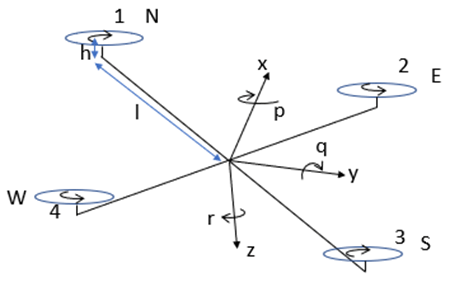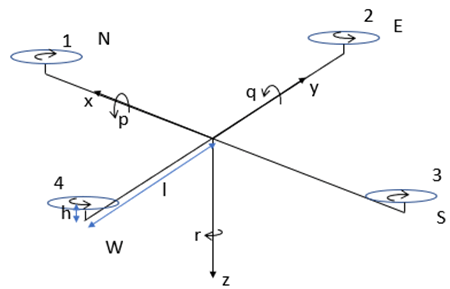このページは機械翻訳を使用して翻訳されました。最新版の英語を参照するには、ここをクリックします。
Multirotor
ライブラリ:
Aerospace Blockset /
Propulsion
説明
Multirotor ブロックは、クワッドコプターなどの複数の回転プロペラまたはローターによって生成される空気力とモーメントを 3 次元すべてで計算します。簡略化されたフラップ、または定常状態の空気力学を含めることもできます。
制限
ブロックは、定常フラップ効果を含めるオプションを備えた簡略化されたアプローチに従います。動的なフラップ、ラグ、またはブレードのフェザリング動作はモデル化されません。
ブロックはピッチ角入力の変化を直接考慮しませんが、ブレードのねじれを変化させることで近似解析を実行することができます。
ブロックは Twist distribution を使用して、線形または理想的なツイスト分布のみをモデル化します。このブロックは、ブレード弦長と揚力曲線の勾配が一定であると想定しています。
ブロックには、モデル内の干渉効果(ローター間)は含まれません。
端子
入力
ローター速度。ボディ座標系内の rad/sec 単位の 1 行 N 列のベクトルとして指定されます。
データ型: double
空気の密度。指定された単位で正のスカラーとして指定されます。
データ型: double
ローターのボディ速度。ボディ座標系内の 3 行 1 列または 1 行 3 列のベクトルとして指定されます。マルチシステム解析を実行するには、State-Space または Integrator ブロックからの出力をこのポートに接続することを検討してください。
データ型: double
車両全体の角速度。ボディ座標系内の 3 行 1 列または 1 行 3 列のベクトルとして rad/s 単位で指定されます。
データ型: double
出力
合計の力。ボディ座標系内の 3 要素ベクトルとして返されます。単位はUnitsパラメータに依存します。
データ型: double
x-y-z 方向のネットモーメント。ボディ座標系の 3 要素ベクトルとして返されます。単位はUnitsパラメータに依存します。
計算されたトルク係数。正のスカラーとして返されます。
依存関係
この出力ポートを有効にするには、次のチェックボックスをオンにします。
Compute CT and CQ
Output computed CT and CQ
計算された推力係数。正のスカラーとして返されます。
依存関係
この出力ポートを有効にするには、次のチェックボックスをオンにします。
Compute CT and CQ
Output computed CT and CQ
パラメーター
| 単位 | 密度 | 力 | 質量 | 速度 | 半径 | コード | ヒンジオフセット |
|---|---|---|---|---|---|---|---|
Metric (MKS) | kg/m3 | ニュートン | ニュートンメートル | メートル/秒 | メートル | メートル | メートル |
English (Velocity in ft/s) | スラグ/フィート3 | ポンド力 | ポンド力フィート | フィート/秒 | 足 | 足 | 足 |
English (Velocity in kts) | スラグ/フィート3 | ポンド力 | ポンド力フィート | フィート/秒 | 足 | 足 | 足 |
プログラムでの使用
ブロック パラメーター: units |
| 型: 文字ベクトル |
値: 'Metric (MKS)' | 'English (Velocity in ft/s)' | 'English (Velocity in kts)' |
既定の設定: 'Metric (MKS)' |
ローター推力計算方法。次のように指定します。
プログラムでの使用
ブロック パラメーター: modelMode |
| 型: 文字ベクトル |
値: 'Without flap effects' | 'With flap effects' |
既定の設定: 'Without flap effects' |
車両
クワッドコプターの構成。次のように指定します。
Quadcopter X—X形状に構成されたプロペラ。Quadcopter +構成よりも安定していると考えられています。Quadcopter +—+の形状に構成されたプロペラ。
詳細については、腕の計算を参照してください。
プログラムでの使用
ブロック パラメーター: config |
| 型: 文字ベクトル |
値: 'Quadcopter X' | 'Quadcopter +' |
既定の設定: 'Quadcopter X' |
車両アームの長さ。ゼロ以外の正のスカラーとして指定されます。この長さは、車両の重心からのローターの変位です。腕の長さの詳細については、アルゴリズム を参照してください。
プログラムでの使用
ブロック パラメーター: l |
| 型: 文字ベクトル |
値: '0.0624' | ゼロ以外の正のスカラー |
既定の設定: '0.0624' |
車両の重心からの垂直オフセット。ゼロ以外のスカラーとして指定されます。
プログラムでの使用
ブロック パラメーター: h |
| 型: 文字ベクトル |
値: '-0.0159' | ゼロ以外の正のスカラー |
既定の設定: '-0.0159' |
回転子
ローターあたりのブレードの数。ゼロ以外の正のスカラーとして指定されます。
依存関係
このパラメータを有効にするには、Compute CT and CQ チェックボックスをオンにし、Modeling を With flap effects に設定します。
プログラムでの使用
ブロック パラメーター: Nb |
| 型: 文字ベクトル |
値: '2' | ゼロ以外の正のスカラー |
既定の設定: '2' |
このチェックボックスを選択すると、ブロックで推力係数とトルク係数が計算されます。これらの計算の詳細については、推力係数とトルク係数の計算 を参照してください。ブロックは、空力パラメータと構造パラメータが一定であると想定します。
推力係数とトルク係数の値を指定するには、このチェックボックスをオフにします。
プログラムでの使用
ブロック パラメーター: CTcheck |
| 型: 文字ベクトル |
値: 'on' | 'off' |
既定の設定: 'off' |
このチェックボックスをオンにすると、計算された推力係数とトルク係数が CT および CQ 出力ポートに出力されます。これらの計算の詳細については、推力係数とトルク係数の計算 を参照してください。ブロックは、空力パラメータと構造パラメータが一定であると想定します。
それ以外の場合は、このチェックボックスをオフにします。
プログラムでの使用
ブロック パラメーター: CTout |
| 型: 文字ベクトル |
値: 'on' | 'off' |
既定の設定: 'off' |
推力係数。ゼロ以外の正のスカラーとして指定されます。
依存関係
このパラメータを有効にするには、Compute CT and CQ チェックボックスをオフにします。
プログラムでの使用
ブロック パラメーター: CT |
| 型: 文字ベクトル |
値: '0.0107' | ゼロ以外の正のスカラー |
既定の設定: '0.0107' |
トルク係数。ゼロ以外の正のスカラーとして指定されます。
依存関係
このパラメータを有効にするには、Compute CT and CQ チェックボックスをオフにします。
プログラムでの使用
ブロック パラメーター: CQ |
| 型: 文字ベクトル |
値: '7.8263e-4' | ゼロ以外の正のスカラー |
既定の設定: '7.8263e-4' |
ローター半径。ゼロ以外の正のスカラーとして指定されます。
プログラムでの使用
ブロック パラメーター: R |
| 型: 文字ベクトル |
値: '0.0330' | ゼロ以外の正のスカラー |
既定の設定: '0.0330' |
ブレード弦。ゼロ以外の正のスカラーとして指定されます。
プログラムでの使用
ブロック パラメーター: c |
| 型: 文字ベクトル |
値: '0.0080' | ゼロ以外の正のスカラー |
既定の設定: '0.0080' |
ヒンジ オフセット。正のスカラーとして指定されます。この値は、プロペラの場合、通常 0 です。
依存関係
このパラメータを有効にするには、Compute CT and CQ チェックボックスをオンにし、Modeling を With flap effects に設定します。
プログラムでの使用
ブロック パラメーター: m |
| 型: 文字ベクトル |
値: '0' | 正のスカラー |
既定の設定: '0' |
リフト曲線の傾き。ゼロ以外の正のスカラーとして指定されます。ブロックは、空力パラメータと構造パラメータが一定であると想定します。ブロックは迎え角に関する変化を考慮しません。
依存関係
このパラメータを有効にするには、Compute CT and CQ チェックボックスをオンにし、Modeling を With flap effects に設定します。
プログラムでの使用
ブロック パラメーター: clalpha |
| 型: 文字ベクトル |
値: '5.5' | ゼロ以外の正のスカラー |
既定の設定: '5.5' |
ロック数。これは、空気力と慣性力の比であり、ゼロ以外の正のスカラーとして指定されます。
依存関係
このパラメータを有効にするには、Modeling を With flap effects に設定します。
プログラムでの使用
ブロック パラメーター: gamma |
| 型: 文字ベクトル |
値: '0.6051' | ゼロ以外の正のスカラー |
既定の設定: '0.6051' |
ローターブレードのねじれ分布は次のように指定されます。
Linear— ブレードのねじれ分布の近似値。Ideal— ブレードのねじれ分布の最適近似。
依存関係
このパラメータを有効にするには、Compute CT and CQ チェックボックスをオンにし、Modeling を With flap effects に設定します。
プログラムでの使用
ブロック パラメーター: twistType |
| 型: 文字ベクトル |
値: 'Linear' | 'Ideal' |
既定の設定: 'Linear' |
ブレード根元ピッチ角 θ0。ゼロ以外の正のスカラーとして指定されます。
依存関係
このパラメーターを有効にするには、次のようにします。
Modeling を
With flap effectsに設定します。Twist distribution を
Linearに設定します。
プログラムでの使用
ブロック パラメーター: theta0 |
| 型: 文字ベクトル |
値: '0.2548' | ゼロ以外の正のスカラー |
既定の設定: '0.2548' |
ブレードのねじれ角度 θ1。正のスカラーとして指定されます。
依存関係
このパラメーターを有効にするには、次のようにします。
Modeling を
With flap effectsに設定します。Twist distribution を
Linearに設定します。
プログラムでの使用
ブロック パラメーター: theta1 |
| 型: 文字ベクトル |
値: '-0.1361' | 正のスカラー |
既定の設定: '-0.1361' |
理想的なねじれ分布のためのブレード先端ピッチ角 θtip。ゼロ以外の正のスカラーとして指定されます。
依存関係
このパラメーターを有効にするには、次のようにします。
Modeling を
With flap effectsに設定します。Twist distribution を
Idealに設定します。
プログラムでの使用
ブロック パラメーター: thetaTip |
| 型: 文字ベクトル |
値: '0.06' | ゼロ以外の正のスカラー |
既定の設定: '0.06' |
アルゴリズム
p 1=(d,-d,-h)
p 2=(d,d,-h)
p 3=(-d,d,-h)
p 4=(-d,-d,-h)
ここで、
lは腕の長さです。
h は車両の重心からのオフセットです。

このグラフィックでは:
x 軸、y 軸、z 軸は互いに垂直です。
車両の 4 本のアームは垂直で、長さが等しい (l)。
すべてのプロペラは同じ高さにあります (h)。
p 1=(l,0,h)
p 2=(0,l,h)
p 3=(-l,0,h)
p 4=(0,-l,h)
ここで、
lは腕の長さです。
h は車両の重心からのオフセットです。

このグラフィックでは:
x 軸、y 軸、z 軸は互いに垂直です。
車両の 4 本のアームは垂直で、長さが等しい (l)。
すべてのプロペラは同じ高さにあります (h)。
力とモーメントは次の式を使用して計算されます。
ここで、
ω は、ローターの回転数(RPM)です。
b と k は実験値です:
ここで、
CTは推力係数である
CQはトルク係数である
[CT と CQ を計算] チェック ボックスをオンにすると、ブロックはこれらの式を使用して推力係数とトルク係数を計算します。
プラントルの先端損失関数を考慮すると、ブレード要素運動量理論を使用した増分推力係数は次のようになります。
ここで、F は補正係数です。
ブレード要素理論を使用すると、増分推力係数は次のようになります。
理想的なひねりを加えて、
その結果:
dCT の 2 つの方程式を等しくすると、次のようになります。
この方程式を解くと、Optimization Toolbox™ から fsolve を使用して λ を取得できます。ツールボックスへの依存性を排除するために、ニュートン・ラプソン法が使用されます。
fun を diff(fun,λ) として微分すると次のようになります。
数値の問題を回避するために、比率は次のように近似されます。
λ が計算された後、半径全体にわたって d CT=4λ2r d r および d CQ =λd CT を合計することによって CT、CQ が計算されます。
参照
[1] Pounds, P. E. I. (2007). Design, construction and control of a large quadrotor micro air vehicle (Doctoral dissertation, Australian National University).
[2] Riether, F. (2016). Agile quadrotor maneuvering using tensor-decomposition-based globally optimal control and onboard visual-inertial estimation (Doctoral dissertation, Massachusetts Institute of Technology).
バージョン履歴
R2023a で導入
参考
MATLAB Command
You clicked a link that corresponds to this MATLAB command:
Run the command by entering it in the MATLAB Command Window. Web browsers do not support MATLAB commands.
Web サイトの選択
Web サイトを選択すると、翻訳されたコンテンツにアクセスし、地域のイベントやサービスを確認できます。現在の位置情報に基づき、次のサイトの選択を推奨します:
また、以下のリストから Web サイトを選択することもできます。
最適なサイトパフォーマンスの取得方法
中国のサイト (中国語または英語) を選択することで、最適なサイトパフォーマンスが得られます。その他の国の MathWorks のサイトは、お客様の地域からのアクセスが最適化されていません。
南北アメリカ
- América Latina (Español)
- Canada (English)
- United States (English)
ヨーロッパ
- Belgium (English)
- Denmark (English)
- Deutschland (Deutsch)
- España (Español)
- Finland (English)
- France (Français)
- Ireland (English)
- Italia (Italiano)
- Luxembourg (English)
- Netherlands (English)
- Norway (English)
- Österreich (Deutsch)
- Portugal (English)
- Sweden (English)
- Switzerland
- United Kingdom (English)